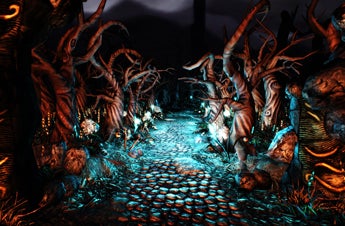The story begins in an ancient abbey, where the player, a young girl, discovers the last light in a world that has been overtaken by darkness.
She guides the light through a scary forest, wielding her torch at enemies and sending them back into the darkness.
This is the setting of the video game Scarfell, which challenges players to restore light to the world and end its curse. It was developed by a team of aspiring video game designers who are students at the Florida Interactive Entertainment Academy, the University of Central Florida’s graduate video game design program.
The student-developers are in their third semester at FIEA, where students learn the game development process by creating original video games.
“This is something you only do when you know you are really passionate about it,” explained Pat Dietz, a graduate production student at FIEA. “A lot of long nights were put into this, but it’s very rewarding when you see it on screen.”
Dietz is the lead designer of Dead West, a video game based in the Old West, with the look of vintage Clint Eastwood cowboy film. In Dead West, the main character, Jack Dixon, is a former lawman turned sharpshooter who returns to the circus and finds that his fellow performers have become zombies. It’s Dixon’s job to put his gun slinging skills to the test to protect the survivors and guide them to safety.
The student teams behind Scarfell and Dead West have been working on the games since January. Their ideas, along with Nexus, a third concept, were selected from a pool of video game pitches to be fully developed into samples.
Once developed, the samples are play tested by other students and the general public, who provide feedback and draw attention to any technical errors. The process gives students the real-world opportunity to turn their ideas into actual working games.
In Nexus, the main player is a character similar to Indiana Jones. When he’s separated from his team while searching for a temple of ruins, he runs into an alien power source that gives his arms the ability to shoot out special shards that have the power to attract and repel objects. He uses his powers to solve puzzles and fight enemies.
To develop the game scenarios, students worked collaboratively and took on different roles in designing, programming and art.
Teams made decisions about the game’s setting and how it will be played– for example, if the character will walk, swim, climb or drive. Then it’s up to the designers and artists to decide what the game’s elements and characters will look like. Finally, the students have to decide how to accomplish the actions in the game.
“The most important thing I’ve learned at FIEA is how to work on a team that consists of students from other disciplines, artists and programmers,” said the Scarfell team’s Andrew Gassen, a graduate production student.
Once the images and controls are finished, the teams hire professional and amateur composers and voice actors to help bring their games to life. After several rounds of play testing, the teams address any issues as they rework their games.
“Typically, game developers are surprised by what players do not understand and the choices that they make,” said FIEA faculty member Ron Weaver. “For this reason, play testing is crucial to creating strong games.”
The edited games will be debuted at a final presentation on Friday, Aug. 5 from 3 to 5 p.m. at UCF’s Center for Emerging Media, 500 W. Livingston St., in downtown Orlando. The public is invited to join family, friends, alumni and industry veterans as they celebrate with the design teams.
To learn more about FIEA, visit http://www.fiea.ucf.edu.
